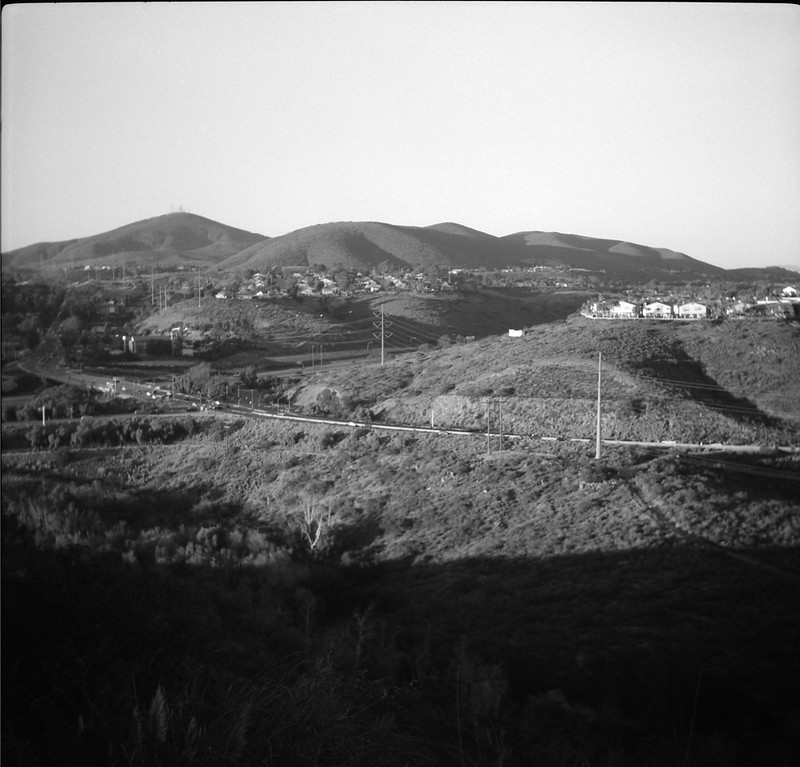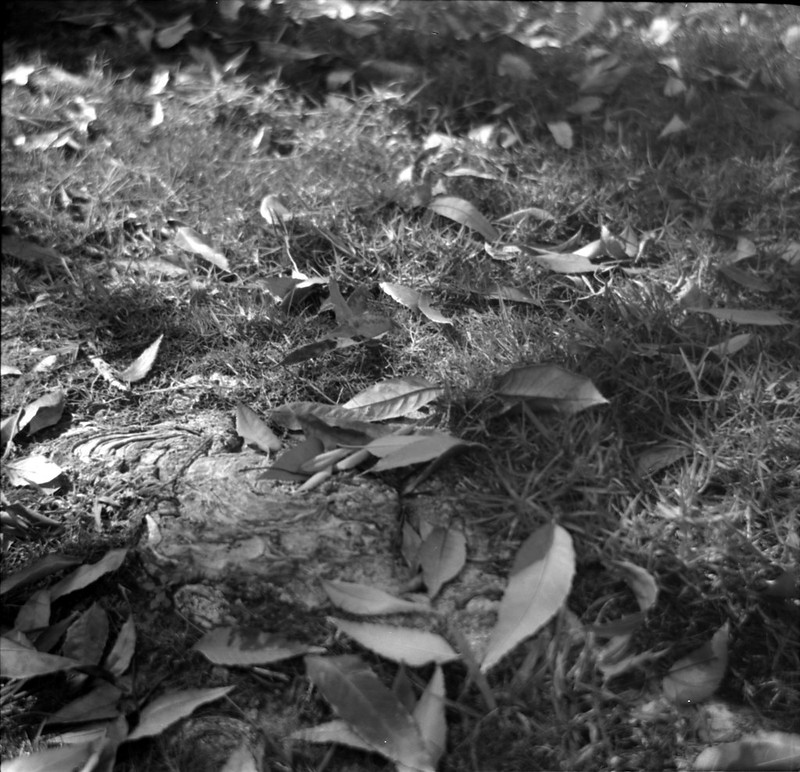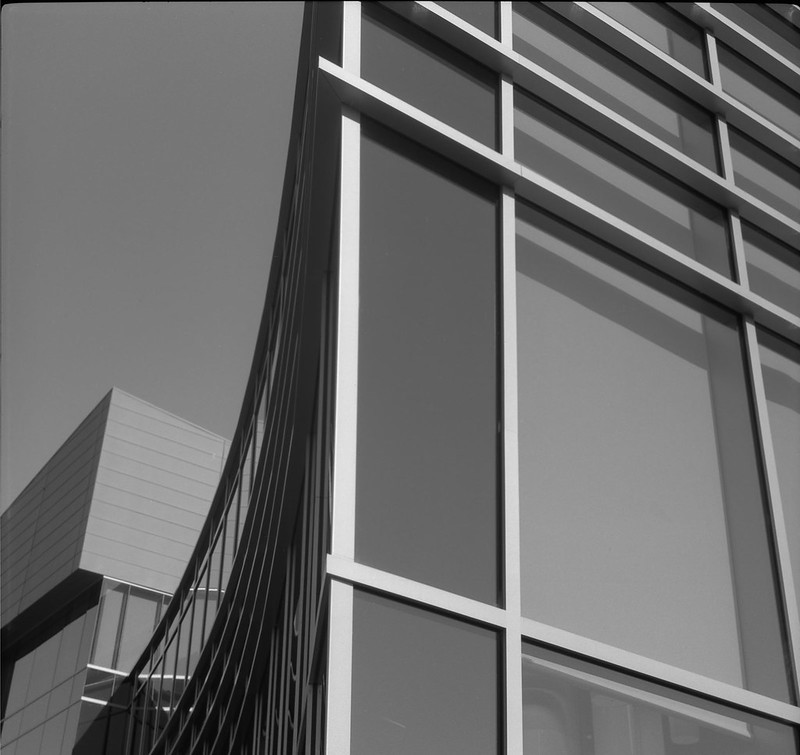In the last post, I left off after assembling the aperture. The shutter leaves go together in a similar fashion only they are all identical and there are only 5. If you took pictures before (I document almost every step with my phone) it should be easy to put it back together like it was. Now the trick is to put the two 'halves' back together. It took me a couple of tries since the shutter leaves tend to move out of position, but I got it back together without too much hassle. One thing I didn't check before putting the screws in was the self timer. It turns out that it doesn't stay cocked. These are notoriously fickle on many old shutters and I don't plan on taking any 'selfies' with this camera, so for now I'm going to leave it. I might change my mind later and take it apart again, but that will take a little more disassebly of gears and whatnot.
I had some trouble getting the front lens element screwed in to the middle element assembly. It just wouldn't start on the threads. The threads are VERY fine and the metal is a little on the soft side, so forcing it is going to end only in sorrow. I sent an email to Jurgen over at Certo6.com and he was very kind and gracious enough to give me this advice.
Hmmmm, happens often with Zeiss front lens units... almost never with Agfas.... hmmmm. Well, when I do run across this annoyance, I make sure I really really clean the threads, first with q-tips and a solvent. Then use a dremel wire brush ( without glass in the brass holders ) to really make sure its clean... this is for both the front lens unit and the middle one that the front screws into. In both cases having removed the glass. If it is still tight or "can't find the thread", then I have to use a very fine polish compound on the front lens unit and work it till it goes in and smoothly. This is really tough on the hands and must be done with the glass in the holders and having the correct size clamp tool on the middle unit ( which is being screwed into ).
A little extra time cleaning the threads with solvent and q-tips and adding a tiny bit of lithium grease did the trick. I got the front element on and screwed all the way down. Notice that the focusing ring isn't on yet. That will be the last step, recollimating the infinity position.
Next I needed to reassemble the top. Before that, I needed to loosen up the rangefinder wheel. It was frozen with the same green grease that tends to freeze the focusing helicoid. I carefully dripped a little bit of Ronsonol lighter fluid being extra super careful that none got anywhere near the mirrors. The coatings on the mirrors are delicate and if you mess them up, your rangefinder is toast. The rest of the top assembly is pretty straight forward. My model has the focusing range reminder on the left, so those small screws took a little finesse to get into their tiny holes.
Now the shutter and the body are assembled. On to the bellows!!

Fist I had to get the old bellows out. There is a roller bar on either side of the film mask. These are just held in by the tension of the metal at the top and bottom on the pins at the ends of the rollers. Push up at the top and down at the bottom near the roller and it will drop out. The rollers are unique, so note which one goes where. Next the film mask needs to come out. There are two screws on either side in the film roll wells. Remove those. Now there is a bit of glue holding the bellows between the mask and the frame of the camera. Start wiggling the mask around gently until you hear the glue start to crack. Then pry gently with a screwdriver or a butter knife. Eventually, the mask will come off. Now pry the bellows out and away from the frame of the body. It will probably tear a little, but we are throwing it away, so no biggie. Use fingernail polish remover to clean the dry glue off of the frame and the mask. It probably doesn't need to be perfectly clean since it is just going to be glued again.

There is a brass plate glued to the front of the bellows that you will need. Get it out and clean off any dry glue or other remnants of the old bellows. You will now need an Isolette III bellows. There are sources to buy them pre-made on the interwebz, but if you have come this far, you may as well make your own, right? There are patterns for free download. I used these from the Most excellent resource RolandAndCaroline.co.uk:
Agfa Isolette Replacement Bellows L&C.pdf
Agfa Isolette Replacement Bellows Ribs.pdf
The first template is for the inner and outer fabric coverings. The second is for the paper stiffeners and for the gluing tower. Download and print two of each.
Now there are some decisions to make. First, what will you use for a light-tight layer? I had a blackout curtain panel laying around. One side is black fabric and the other is coated with white rubber making it light-tight. I used one of the 'L&C' templates to cut out the piece I need. It turns out that the template is a little bigger than I need, but it's easy enough to trim later. Next I cut the stiffener ribs out of a thin card stock. It is a little stiffer than regular paper, but not much thicker. You have to be conscious of the thickness of these layers because if they are too thick, they won't properly fold into the camera. It will still take photos, but you just won't be able to fold it and take advantage of one of the awesome features of these MF cameras. I also cut one of the stiffener panels in half so that the overlap would happen in the middle of a panel and not at a corner. That is more of an aesthetic choice than a practical one. Here you can see that the opaque cloth is going to have a lot of overlap when I go to glue it. I trimmed it down so that it only extends about 1/4 inch past the stiffeners.

Once I glued the stiffeners down to the cloth, I let the glue dry and cut the 'support' sides off of the paper stiffeners so that only the 'ribs' are left. Then I cut the cloth as described above.
Next, I needed to make a structure that would hold the flexible (I might even call it 'limp') cloth/stiffeners assembly so that I could glue the seam. I used foam core and Gorilla Tape. I cut two of the 'stiffener' panels from the pattern linked above. Then I cut two more that were narrower by the exact thickness of the foam core. It just so happened that the 'border' lines on the pattern are exactly the thickness of my foam core, so I just cut along those inner lines and it came out to be the perfect width. I also cut all of the pieces a couple of inches longer than the template. I taped them all together and then measured the dimensions of the opening at the bottom of the 'pyramid'. I cut a square of foam core to that dimension and taped it in. This gives the structure more rigidity and keeps things square.
I then put some contact cement on the edges of the cloth and wrapped my 'bellows' around the tower so that the edges of the 'half-ribs' all lined up.
Next will be to glue the outer covering on to the bellows, fold them and install them into the camera. Stay tuned to see it all come together (fingers crossed).































